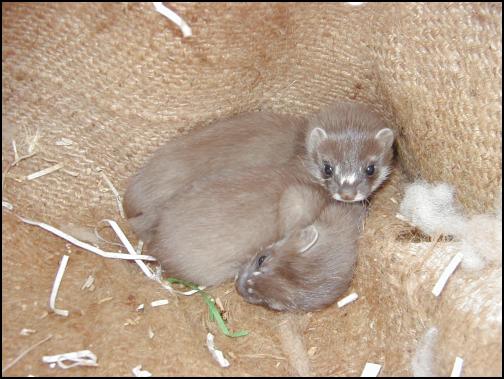'Natural Born Killers' Bred In NZ For First Time
13 December

'Natural Born Killers' Bred In New Zealand For The First Time
New Zealand's most ferocious predators, the stoat, has been bred in captivity for the first time in the Southern Hemisphere. Scientists say this will help them find ways to stop stoats breeding as prolifically in the wild.
Stoats (Mustela erminea) are native to Europe, America and Asia. Along with other mustelids, they were brought to New Zealand in the late 1800s to control rabbits, despite the protests of bird experts. Now stoats are known to kill up to 60% of all North Island kiwi chicks and wreak havoc on other native bird populations, killing far more than they need to survive. Stoats are secretive and elusive, and are difficult to catch and study.
The Department of Conservation funds Landcare Research to investigate ways to restrict stoat breeding. Scientists must actually breed stoats to find out more about stoat life cycles, and have healthier animals to study. Now, for the first time, two baby stoats or 'kits' have been born at Landcare Research's animal facility at Lincoln in Canterbury.
DOC Stoat Control Research programme manager Dr Elaine Murphy says stoats have rarely been born in captivity. "It is a real breakthrough to have bred them in New Zealand. Pregnant female stoats have been brought into captivity a number of times, but have never given birth.
"We eventually want to breed our two kits on, to get the larger litters of eight or nine that stoats generally produce in the wild".
Landcare Research Pest Control and Wildlife Toxicology team leader Dr Cheryl O'Connor, the kits' official 'auntie', says the youngsters are now about seven weeks old, but were only discovered a fortnight ago. "We left the mother alone for as long as possible, to minimise stress. Finally we discovered the kits hiding in their nest. They are still cute, fluffy and weak like kittens, but when they reach their full weight of about 250 grams they will hiss and bite with the best of them.
"We think the most important thing we did right in breeding the stoats was to disturb them as little as possible. If the family is upset, the mother can eat her offspring, or abandon the nest, leaving them to freeze".
Dr O'Connor says what is known about stoat reproduction so far is strange and fascinating. "After mating in November or December, female stoats store embryos for about nine months. Seasonal changes in hours of light and darkness trigger the embryos to implant in the uterus and start growing, and the infants are born about a month later.
"We want to see if we can disrupt light and dark patterns to speed that process up, to produce more animals more quickly".
Dr Murphy says once the captive stoat population is built up, research into restricting birth numbers can begin in earnest.
"We will try to devise fertility control methods, to make the stoats' own immune system react against its eggs. We will also look at treatments that may stop embryos implanting".
Dr O'Connor says many people do not realise what a menace stoats are in the wild. "Stoats are quick and clever and most people have never seen one. But like possums, stoats are having a huge impact on our natural heritage. In critical areas, just one stoat in the wrong place can do a lot of damage".
ENDS


 Tourism New Zealand: Tourism New Zealand Invites The World To Find Their 100% Pure New Zealand In New Global Campaign
Tourism New Zealand: Tourism New Zealand Invites The World To Find Their 100% Pure New Zealand In New Global Campaign Bill Bennett: Comcom warns 2degrees over satellite marketing
Bill Bennett: Comcom warns 2degrees over satellite marketing Transpower: Major Electricity Development For Western Bay Of Plenty A Step Closer
Transpower: Major Electricity Development For Western Bay Of Plenty A Step Closer Alcohol Beverages Council: Turning The Tide - New Zealanders Unite To Curb Harmful Drinking
Alcohol Beverages Council: Turning The Tide - New Zealanders Unite To Curb Harmful Drinking University of Auckland Business School: Economists Urge Action To Prevent ‘AI Poverty Traps’
University of Auckland Business School: Economists Urge Action To Prevent ‘AI Poverty Traps’ Bill Bennett: Australian warship takes rural fixed wireless broadband offline
Bill Bennett: Australian warship takes rural fixed wireless broadband offline


